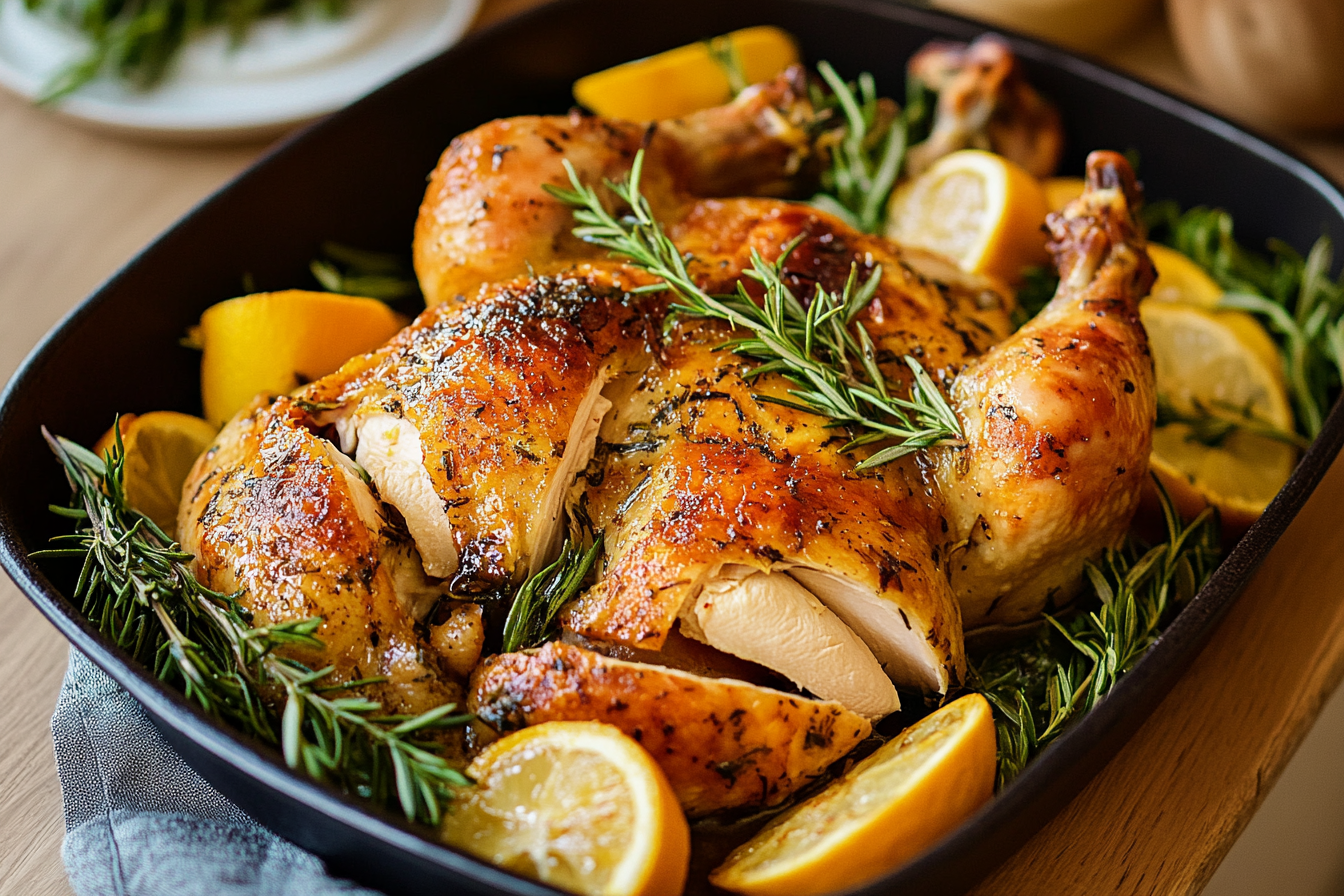When it comes to creating delicious, tender, and flavorful chicken, brining is a culinary technique that cannot be overlooked. Whether you are a home cook or a seasoned chef, understanding how to brine chicken can elevate your cooking to restaurant-quality levels. This comprehensive guide will cover everything you need to know about brining chicken, from a basic chicken brine recipe to expert techniques and variations that will bring out the best in your poultry. Plus, we’ll delve into frequently asked questions, common mistakes, and much more to ensure your chicken is always perfectly juicy and packed with flavor. For more insights into ingredient pairings, check out Why do cherries and chocolate go together?, a delicious combination explained in detail.
What is Chicken Brine?
At its core, a chicken brine recipe is a solution of salt and water that is used to soak chicken before cooking. The process of brining allows the salt to penetrate the meat, enhancing moisture retention and seasoning the chicken from the inside out. Brining works through osmosis, where the salt draws out the chicken’s natural juices, then reabsorbs them along with the flavors of the brine.
But why stop at salt and water? You can enhance the basic brine with herbs, spices, sugars, and even fruit juices to create a complex and rich flavor profile. The beauty of brining is its versatility. No matter what flavors you’re craving, there’s a way to work them into your brine. If you’re interested in how flavors pair well together, check out What is the most expensive chocolate cake ever?.
Why You Should Always Brine Chicken
Cooking chicken perfectly is challenging because of its low-fat content. Lean cuts like chicken breasts are especially prone to drying out, leading to tough, rubbery textures. By using a chicken brine recipe, you ensure that the chicken stays moist, tender, and flavorful no matter how it’s cooked—grilled, roasted, fried, or smoked. Pair your delicious chicken dishes with a dessert like Decadent Homemade Chocolate Cake for a complete meal experience.
Key Benefits of Brining Chicken:
- Increased Moisture: Brining helps the chicken retain moisture, making it juicier after cooking.
- Enhanced Flavor: A brine penetrates deep into the meat, seasoning it from within.
- Improved Texture: The salt breaks down muscle proteins, resulting in a more tender texture.
- Even Cooking: Since the chicken retains more moisture, it is less likely to dry out during cooking, allowing for even, consistent results.
The Science Behind Brining
Brining works due to osmosis and diffusion. When you soak chicken in a saltwater solution, the salt draws out the meat’s moisture. This might sound counterproductive, but here’s the trick: as the salt is absorbed by the chicken, it begins to relax the protein fibers, which in turn allows the meat to reabsorb the liquid. In the process, the salt alters the muscle fibers, allowing them to retain more moisture when cooked.
The result? Juicier, more flavorful chicken that can withstand high-heat cooking methods like grilling and roasting without becoming dry.
Basic Chicken Brine Recipe
Ready to brine your chicken? Here’s a simple, foolproof recipe to get you started.
Ingredients:
- 4 cups water
- ¼ cup kosher salt (or 2 tablespoons table salt)
- ¼ cup brown sugar (optional)
- 2-3 garlic cloves, smashed
- 2 bay leaves
- 1 tablespoon black peppercorns
- Optional: fresh herbs like rosemary, thyme, or parsley
Instructions:
- In a large pot, combine water, salt, and sugar (if using). Stir until dissolved.
- Add garlic, bay leaves, peppercorns, and any optional herbs.
- Let the brine cool to room temperature. (Never add chicken to hot brine as it could begin to cook the chicken prematurely.)
- Submerge the chicken in the brine, ensuring it’s fully covered.
- Cover the container and refrigerate for at least 4 hours, but no more than 24 hours.
- After brining, rinse the chicken under cold water to remove excess salt and pat dry with paper towels before cooking.
Pro Tip:
For a richer flavor, try replacing part of the water with other liquids like apple cider, beer, or even chicken broth. Keep in mind that you’ll need to adjust the salt content accordingly if using pre-seasoned liquids. For those interested in experimenting, here’s a creative guide to flavoring brines.
Adjusting Your Chicken Brine Recipe for Different Cuts
Not all chicken parts require the same brining time. Here’s a handy guide to adjust the time and ingredients based on what part of the bird you’re preparing.
Chicken Breasts:
Lean and prone to drying out, chicken breasts benefit greatly from brining. A simple brine of 2-4 hours works best. Brining them longer can lead to a mushy texture.
Chicken Thighs:
Chicken thighs are fattier and more forgiving when cooking. You can brine them for 3-4 hours for a boost in flavor without affecting texture.
Whole Chicken:
A whole chicken needs more time to allow the brine to penetrate fully. Aim for at least 12 hours, but you can brine a whole chicken for up to 24 hours for maximum flavor.
For more baking inspiration to complement your brined chicken, consider trying a Pumpkin Banana Loaf as a sweet finish to your meal.

Salt-to-Water Ratio for Chicken Brine
The ratio of salt to water in your chicken brine recipe is critical to ensuring the perfect balance of flavor. Here’s a standard ratio:
- For every 4 cups of water, use ¼ cup kosher salt.
This basic ratio is tried and true, but if you’re using table salt, remember that it’s finer and more concentrated. You’ll only need about 2 tablespoons of table salt to achieve the same level of saltiness. For more detailed instructions and tips, you can also check out this salt-to-water guide
Measuring the Right Amount of Salt:
- Kosher Salt: ¼ cup per 4 cups of water.
- Table Salt: 2 tablespoons per 4 cups of water.
- Sea Salt: Depends on the coarseness but generally matches kosher salt amounts.
Types of Salt for Chicken Brine
You may not think the type of salt you use in your brine makes a difference, but it can affect the outcome of your chicken brine recipe.
Kosher Salt:
Most commonly used in brining, kosher salt’s larger flakes dissolve slowly, providing a balanced saltiness.
Table Salt:
While usable, table salt is much finer and dissolves faster. Use less of it compared to kosher salt for the same result.
Sea Salt:
Sea salt offers a slightly more complex flavor due to the minerals in the water it’s harvested from. If you prefer a subtle flavor difference, sea salt is a great choice.
Wet Brine vs. Dry Brine
When discussing how to brine chicken, you’ll come across two methods: wet brining and dry brining. Both have their merits, and the choice often comes down to personal preference and available time.
Wet Brine:
A traditional brine involves submerging the chicken in a saltwater solution. Wet brines add more moisture, making them ideal for lean cuts like chicken breasts.
- Pros: Provides moisture and can infuse additional flavors through added spices or liquids.
- Cons: Requires more space in the fridge and can be a bit messier.
Dry Brine:
Dry brining, on the other hand, is when you coat the chicken in salt and leave it uncovered in the refrigerator. The salt draws moisture to the surface, which is then reabsorbed, seasoning the chicken and creating a crispier skin when cooked.
- Pros: Requires less space, enhances flavor, and creates crispy skin.
- Cons: Does not add extra moisture, making it less suitable for very lean cuts.
How to Brine Chicken for Smoking
Smoking chicken can be tricky because it’s cooked slowly over low heat, which can dry it out. A brine ensures that your chicken will stay moist and flavorful even after hours in the smoker.
Ingredients for Smoked Chicken Brine:
- 8 cups water
- ½ cup kosher salt
- ½ cup brown sugar
- 2 cloves garlic, minced
- 1 tablespoon black pepper
- 1 tablespoon paprika
- 1 teaspoon crushed red pepper flakes (optional)
- 1 lemon, sliced
Instructions:
- Dissolve salt and sugar in water over low heat.
- Add garlic, pepper, paprika, red pepper flakes, and lemon slices.
- Let the brine cool, then submerge the chicken for at least 4 hours, preferably overnight.
- Rinse and dry the chicken before smoking for the juiciest result.

How to Brine Chicken for Frying
Fried chicken is a comfort food favorite, and brining ensures that the meat stays juicy while the outside gets crispy. Here’s a simple chicken brine recipe for the best fried chicken:
Ingredients:
- 4 cups water
- ¼ cup kosher salt
- ¼ cup sugar
- 2 cloves garlic, smashed
- 1 tablespoon paprika
- 1 tablespoon black pepper
- 1 teaspoon cayenne pepper
Instructions:
- Combine water, salt, sugar, and seasonings in a large pot. Stir until dissolved.
- Cool the brine and submerge the chicken pieces.
- Refrigerate for 2-4 hours.
- Pat dry and fry until golden brown and cooked through.
How to Brine Chicken for Roasting
Roasted chicken with crispy skin and tender meat is a true delight. Brining the chicken beforehand enhances its flavor and texture.
Ingredients:
- 8 cups water
- ½ cup kosher salt
- ¼ cup honey
- 2 sprigs rosemary
- 1 tablespoon black pepper
- 2 bay leaves
- 1 lemon, sliced
Instructions:
- Heat the water with salt, honey, and seasonings until dissolved.
- Let the brine cool before adding the chicken.
- Brine for 8-12 hours, then rinse and dry.
- Roast at a high temperature for crispy skin and juicy meat.
Flavor Variations for Chicken Brine Recipes
While the basic chicken brine recipe is effective on its own, the addition of other ingredients can elevate the flavor profile. Below are some exciting variations to try.
Herb-Infused Brine:
Add fresh herbs like thyme, rosemary, and parsley for a fragrant, earthy taste. You can also add crushed garlic for a burst of flavor.
Sweet and Smoky Brine:
Add ¼ cup of maple syrup or molasses and a tablespoon of smoked paprika for a sweet, smoky taste, perfect for grilled or smoked chicken.
Citrus Brine:
Add the zest and juice of oranges, lemons, or limes for a bright, zesty flavor. This variation is ideal for summer grilling or roasting.
Spicy Brine:
For a kick, add crushed red pepper flakes, chili powder, or even sriracha to the brine. This works particularly well for fried or grilled chicken.
Common Mistakes to Avoid When Brining Chicken
Brining is simple, but there are a few pitfalls that can negatively affect your results.
- Over-brining: Brining for too long can make the chicken too salty or mushy. Stick to the recommended times.
- Not rinsing: Always rinse the chicken after brining to remove excess salt.
- Hot brine: Never add chicken to hot brine. This could start to cook the chicken and affect the texture.
- Incorrect salt amounts: Be sure to follow the proper salt-to-water ratio. Too much salt can overpower the dish.

FAQs:
Can you brine chicken too long?
Yes, leaving chicken in a brine for too long can make it overly salty and give it a mushy texture. Stick to the recommended brining times—2-4 hours for smaller cuts, and no more than 24 hours for a whole chicken.
Should I rinse chicken after brining?
Yes, rinsing the chicken helps remove excess salt from the surface. After rinsing, be sure to pat it dry with paper towels for the best texture during cooking.
Can you brine chicken without sugar?
Yes, sugar is optional. It adds a subtle sweetness and helps with caramelization, but you can skip it if you prefer a more savory flavor.
What happens if you don’t rinse brined chicken?
If you don’t rinse brined chicken, the outer layer might be too salty, which can throw off the balance of your final dish.
Can I use table salt instead of kosher salt?
Yes, but you’ll need to adjust the amount. Table salt is denser than kosher salt, so use about half the amount of table salt compared to kosher salt.
How long can brined chicken stay in the fridge?
Once brined, you should cook the chicken within 24-48 hours. Be sure to store it in an airtight container in the refrigerator to maintain freshness.
Conclusion
Brining chicken is an essential technique for ensuring that your poultry dishes come out juicy, tender, and flavorful every time. By following the chicken brine recipe outlined in this guide, you’ll elevate your cooking and impress your guests with perfectly cooked chicken. Whether you’re grilling, frying, roasting, or smoking, brining will take your chicken from ordinary to extraordinary. Experiment with different flavors and find your favorite variation of the brine. Just remember to follow the salt-to-water ratio and brining times to avoid common mistakes.
Happy cooking, and enjoy your brined chicken!
